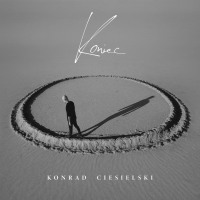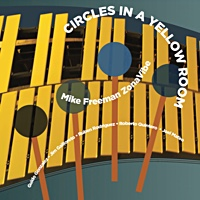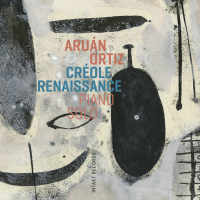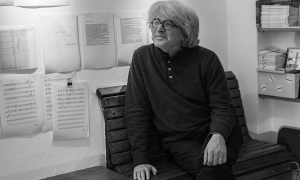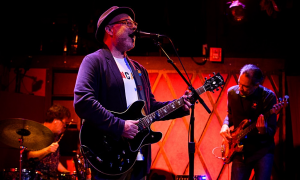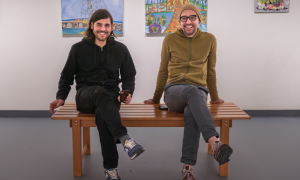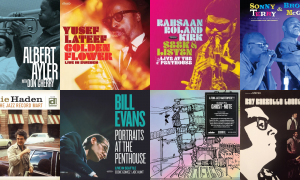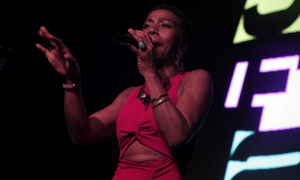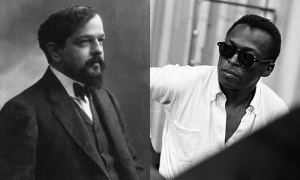Home » Jazz Articles » Interview » Benevento/Russo Duo: Hero Rock, Mind-Reading and Constant Movement
Benevento/Russo Duo: Hero Rock, Mind-Reading and Constant Movement
'Best Reason' was kind of the crossing point of us becoming a band, of developing our own sound. So on this one we were just confident and ready to say, 'Okay, this is us. We don
Keyboardist Marco Benevento and drummer Joe Russo formed the Benevento/Russo Duo in 2002 in response to Russo being offered a Thursday night residency at the Knitting Factory, New York's still-iconic Downtown improv club. Although the two New-Jersey-raised players were still each well short of thirty, they'd been knocking around New York for several years already, playing countless gigs with all sorts of players. The motivation behind the Duo's formation was, to a great extent, an economic one—at $100 a show, it seemed to Russo that a duo formation was more advisable than any larger musical configuration.

What the Benevento/Russo actually was during this period wasn't terribly defined. They were an organ and drums duo, and they jammed a lot, filling out the skeletal forms of their compositions with undiscussed, blazing improvisation—20-minute songs were not uncommon. These epic improvisational originals coexisted alongside covers of tunes by rock bands like Led Zeppelin, Nirvana or Radiohead, often just as improv-stuffed (as well as altered by new time signatures) as the aforementioned originals. The music was loud, peculiar and grooving—as much free jazz as indie rock. What they played was, well, what they played: whatever the music was, it was uncalculated, devoid of preconceived intention.
Two self-published CDs in this musical vein gave the growing Thursday night Knitting Factory crowds something to take home after the gig, but a one-record contract with Ropeadope Records led to last year's Best Reason to Buy the Sun, something altogether new and unexpected from the band. Sure, the music grooved. Yes, there was plenty of improvisational playing from Benevento on his trademark Wurlitzer and Hammond, and from guests like saxophonist Skerik and vibes player Mike Dillon. But there were also songs—glorious, concise, melodic gems like "Sunny's Song that stuck in the listener's mind. Best Reason was far and away one of the best recordings of the year, and it propelled the by now hard-touring Duo to a new level of popularity both in the jamband and jazz communities. 2006 saw the group appearing both at the Lollapalooza rock festival and on a big-venue tour with former Phish members Trey Anastasio and Mike Gordon (where they did sets as the Duo and with Gordon and Anastasio).
No fan of Best Reason would fail to recognize the band on its new Reincarnate Music release Play Pause Stop—Benevento's Wurli and Hammond are as distinctive as ever, and no one could miss the melodic muscle and Hammond-pedal bass lines that are the band's signatures. But the music's even more streamlined; the songs on Play Pause Stop are more concise, structured and hook-laden than ever before and the romping bass lines that were such a significant part of Best Reason's tunes are often more functional and song-serving. Instrumental music doesn't get much better than this, but no one could mistake this stuff for jazz—it's not even jazz-rock. It's rock music, pure and simple—but its sparkling textures, interlocking parts and technical acumen make it unlike any other rock music that's being created nowadays.
I saw the Benevento/Russo Duo play in October at Chicago's Park West, and they were very, very good. The crowd was an odd mix of hard-dancing young hippies and intermittently-attentive, beer-dazed fraternity brothers, but if the audience's attention occasionally waned, the band's performance didn't—the relentlessly gleeful Benevento and the intense, unsmiling Russo faced each other with complete concentration as they worked through pretty much all of Play Pause Stop, a good section of Best Reason to Buy the Sun and a long, wandering free improvisation (Benevento waggishly making faces as he hit dissonant notes on his Wurlitzer). The music is completely audience-friendly, but the musicians play to each other. Everything sounded glorious—despite the fact that a Duo fan from 2002 might not even recognize this as the same band.
Due to the group's relentless touring schedule, I interviewed Marco Benevento and Joe Russo in separate telephone conversations as their van hurtled across Arizona en route to Austin, Texas. This took some doggedness: phones faded and dropped out as they drove in and out of cell-phone coverage, so that the following interview is more than two separate interviews sewn together—it's the collective sum of several sections of many abbreviated conversations, all originally separated in real time by the abrupt punctuation of cell phone failure.
The Duo didn't mind. Although Russo's a darker personality than the irrepressibly upbeat Benevento, they were both affable, engaged and forthcoming as they spoke about the new album, the group's gradual journey towards more disciplined, defined song structures, the way they share the music's melodic materials live and on record, and much more.
All About Jazz: You've just put out your great new CD Play Pause Stop. The previous CD, Best Reason to Buy the Sun, which came out in 2005, was very impressive, but I think this new one is even better. I think it continues a conscious, intentional trend towards simplicity and presentation of real songs—the arrangements exist to really put the songs across, as opposed to the songs existing to fuel improvisation or soloing. That doesn't really sum up everything happening here, but this is deeply memorable, melodic music that's also propulsive and interesting. You could have gone in a more groove or jam-themed direction and still packed them in live. So what's led to this direction? Marco Benevento: I think it was just a natural progression of our musical lives. When we were in New York from 1999 through 2002, the music we played was very groove-oriented, and there were also a lot of jazz odysseys—long, exploratory, improvisational stories. We were doing a lot of that in the Knitting Factory, and we would just play organ and drums and do lots of soloing—play a little melody but then just go into the solo section and just make shit up and go with that for a while. We're talking about two years of doing that. So I think that over time, we just wanted to trim the fat and kind of get into some tasty melodies and just have a little song. The first song where we did that was "Sunny's Song, and originally it felt really weird to play it, because we'd play "Scratchitti for fourteen minutes, or we'd play "Darts for eleven minutes with an improv section in five, all this long exploratory stuff. We'd play [Nirvana's] "Smells Like Teen Spirit in seven and trip it out, and so on. Then we'd do "Sunny's Song, which is this three-minute thing, and it was a little bit awkward, because we'd just played a three-minute song, and it was over. People were like, "Oh, right—clap. That was the song. I thought, "Oh, god—it's going to be difficult to get into this. But a lot of people liked it, and I liked it too. At the time, we were listening to Radiohead, Wilco, The Shins, Broken Social Scene, and going back to our rock roots and listening to Zeppelin and this awesome band from L.A called I Am a Robot, so I think just listening to different stuff on the road had an influence on us.
Marco Benevento: I think it was just a natural progression of our musical lives. When we were in New York from 1999 through 2002, the music we played was very groove-oriented, and there were also a lot of jazz odysseys—long, exploratory, improvisational stories. We were doing a lot of that in the Knitting Factory, and we would just play organ and drums and do lots of soloing—play a little melody but then just go into the solo section and just make shit up and go with that for a while. We're talking about two years of doing that. So I think that over time, we just wanted to trim the fat and kind of get into some tasty melodies and just have a little song. The first song where we did that was "Sunny's Song, and originally it felt really weird to play it, because we'd play "Scratchitti for fourteen minutes, or we'd play "Darts for eleven minutes with an improv section in five, all this long exploratory stuff. We'd play [Nirvana's] "Smells Like Teen Spirit in seven and trip it out, and so on. Then we'd do "Sunny's Song, which is this three-minute thing, and it was a little bit awkward, because we'd just played a three-minute song, and it was over. People were like, "Oh, right—clap. That was the song. I thought, "Oh, god—it's going to be difficult to get into this. But a lot of people liked it, and I liked it too. At the time, we were listening to Radiohead, Wilco, The Shins, Broken Social Scene, and going back to our rock roots and listening to Zeppelin and this awesome band from L.A called I Am a Robot, so I think just listening to different stuff on the road had an influence on us.
Joe Russo: That's the music we wanted to make. We did the improv thing for a long time, which is still something we still love to do. But in terms of choosing direction, it was just a natural move. We didn't really think it out too much. We just started writing more in that vein, and as time went on, it's kind of matured into what we we're doing. And the groove shit is not really us. The music we're listening to is more hook-oriented rock music, so it just naturally came out when we were both writing. It just flowed naturally.
MB: After playing that other stuff for many years, we were ready to just try something else. It wasn't a conscious decision: "We need to change our sound. It didn't get talked about, really. Joe and I are very good at not talking about what needs to happen; it just kind of happens. There's a lot of mind-reading, a lot of vibe-reading. It's a sensitive thing; you don't want to force anything. So we recorded Best Reason and got way into the songs, and with this one, Play Pause Stop, I think that just increased. This time, we got way into playing almost guitar-esque kinds of songs. I actually started writing "Something For Rockets in A-flat, and we were on tour with Something For Rockets, this great band—that's where we got the name for the song. And I was trying to teach it to them: "I kind of have this song idea. It's A-flat to B-flat minor, And they were just like, "Oh, fucking keyboard keys.
So I thought, "Why don't I just arrange it in A? Or D, or E? I'll just write in simple guitar keys. So I just moved it up to a better key. And Joe kind of strayed away from the drum pad a little bit more on this album, which was what he wanted to do, and that was kind of cool. Best Reason was filled with lots of complex and somewhat nerdy drum-machine-sounding rhythms. So now I see Joe playing air guitar when he listens to Play Pause Stop—and there's no real guitar in the band.
AAJ: There also aren't any guest musicians on this one—no Skerik, no Mike Dillon, no Smokey Hormel, all of whom played on Best Reason to Buy the Sun.
MB: Right. We wanted to make our own album. We felt pretty solid just being the Duo. The other reason we had those guys on Best Reason was that they would play that stuff with us every time we would do a show together. We were around them a lot at that time, so we thought, "It's not complete without them. We should fly them in and record them.
JR: On the first one, we were still so new, and maybe not as confident in what we were doing, so it was kind of a safety net to have other people with us. But after the last year of us touring a lot and maturing as musicians and people, and just really getting into what we were doing, we just felt more confident. This has developed into a band. Best Reason was kind of the crossing point of us becoming a band, of developing our own sound. So on this one we were just confident and ready to say, "Okay, this is us. We don't need any guests to make this one happen.
AAJ: Well, this one does give more of an accurate impression of what the listener's going to get if he buys a ticket to see the band play.
JR: Definitely. And like Marco says, we were playing with Skerik and Mike a lot at that time, and a lot of those songs were written during that time we were playing with those guys, so it did seem natural to have them on it. This time, we'd been doing such an amount of just duo that we'd covered all the bases on our own.
AAJ: Well, I love their contributions to that record, but I do enjoy that everything on this newer one is just you two.
MB: Yeah. We spent the majority of January right before we recorded this album—which was in February—just down in my basement working on arrangements of tunes and finishing unfinished tunes. So a lot of the songs were really fresh and we went into the studio really excited to see how they were going to turn out.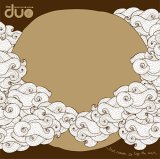 AAJ: So if you had worked out the arrangements ahead of time, then all you had to do in the studio was just track it?
AAJ: So if you had worked out the arrangements ahead of time, then all you had to do in the studio was just track it?
MB: Well, I have ProTools at my house, so we'd put a couple of mikes in the room and recorded, just to hear, before we went into the studio, how the arrangements were working out. We messed with that, and it was good; we don't get to do that so much because we're on the road so much. So just doing that was a great experience. We had five tunes that were tested on the road that we had played for a while, and then there were four or five that we hadn't really finished or tested. So it was half tunes that people had heard, and half new tunes.
AAJ: There's really an anthemic quality to a lot of the songs on Play Pause Stop. The title track and, in its way, "Soba are really rock anthems. There's a tongue-in-cheek quality, but they're sonic movies with a real anthemic heft.
JR: Yeah, there are definitely some anthems in there. And I don't know where that's coming from. There definitely is a bit of a tongue-in-cheek thing about it. I think we gave up on worrying about anything like that—worrying about overdoing it. But when we were writing this stuff, we would hit these sections and kind of giggle a little bit: "Oh my god, this is some kind of hero rock. But we just ended up saying, "Fuck it, man, it's awesome. We love it. We just went with it. I think it's a guilty pleasure from our Jersey roots, to just have that obvious hook and the big rock anthem. It's kind of fun, and you might as well embrace it. We have a lot of other interesting things going on to balance that, so I think it's fun to throw that in sometimes.
AAJ: By today's CD standards, this album is nice and short—like an LP. Was this something you wanted to do?
JR: Yeah, for sure. We only went in with so much material, and once we realized it was only 50 minutes or so, we thought that was fine. So many good records are short. If they're really long, it's hard to ingest some of the stuff. So I thought it was a good move to make a shorter disc. Less is more.
AAJ: Well, the last couple tunes on a really long record might be the greatest songs ever recorded, but you never even find out how they go.
JR: Right. You never even get to that point. I like the way the record came out. I feel like it tells a nice little story and all flows together. I'd rather have a shorter album that does that. Like you said, even if there are really good tunes at the end of a longer one, it's hard to ingest it all. We like the length of it; we're definitely not trying to fit anyone's mold, not listening to anyone saying we need to have a 70-minute CD. Fuck that. We have 50 minutes of music, and we'll just put that out.
AAJ: So was the record recorded mostly live?
MB: Totally. [Co-producer and sole engineer and mixer] Tom Biller was really good at knowing when it wasn't happening and when it was. We played live in this little, little studio, and we didn't take too many takes of each tune. So yeah, for the most part it's all live. We did some keyboard overdubs, some guitar stuff, but for the most part all that stuff is live.
AAJ: I get the impression that when you're putting your songs together, you really think about texture and contrast. There are a lot of colors to the keyboards, and a song like "Soba really plays different keyboard textures against each other, with its adamant Wurlitzer and long Hammond notes. I assume you put some thought into this sort of arranging.
MB: Yeah, definitely. That was an interesting process, and the whole mixing process was an amazing thing to watch. That's where all that would come out, in mixing. I know that how we blend the organ, the Wurli and the bass is crucial, and watching Tom Biller mix 23 tracks of just two guys was pretty intense—the laying, the texturing, making sure that a certain part would come out stronger. That's definitely a conscious effort I make with layering stuff and making sure that I'm using the right sound. We experiment with different tones, that sort of thing.
AAJ: You two write together and separately. "Soba is a Marco composition; "Echo Park is Joe's song, and there are tunes you write together. When you write together, how do you work as a team? Let's take "Best Reason to Buy the Sun, which is a classic Benevento/Russo track, in my opinion, and has some of Joe's finest drumming on record. How was this one written? JR: That one was independent writing on each of our parts. Marco had that opening riff—I think we were somewhere in Canada, actually. Marco said, "Hey, check this riff out, and it was cool, and we played on it for a minute. Then I said, "I've got something I've been working on, too, which became the verse and chorus sections. Then Marco put the bridge in. So that was a very down-the-middle tune. That was the first time we had done that, I think—where we were just compiling ideas that we had worked on independently, which has become a trend in our writing. He and I will write apart from each other and then bring it in and piece it together. It's fun because it puts each of our voices into a song. That's been happening a lot.
JR: That one was independent writing on each of our parts. Marco had that opening riff—I think we were somewhere in Canada, actually. Marco said, "Hey, check this riff out, and it was cool, and we played on it for a minute. Then I said, "I've got something I've been working on, too, which became the verse and chorus sections. Then Marco put the bridge in. So that was a very down-the-middle tune. That was the first time we had done that, I think—where we were just compiling ideas that we had worked on independently, which has become a trend in our writing. He and I will write apart from each other and then bring it in and piece it together. It's fun because it puts each of our voices into a song. That's been happening a lot.
Other times, we'll work out stuff together—but more often than not, we both come in with ideas and just try to throw them together. A lot of times, it really does work out really well, and develops this different thing, because maybe the direction that he was going in with his thing, or the way I thought I was going with mine, get switched around as we combine them. It takes a whole different turn and makes it interesting.
AAJ: How about "Something For Rockets, another group composition, with its great drifting space melody playing off that little arpeggiating phrase. How'd the two of you write that one?
MB: Oh, that's a good example. That's a perfect one, because that was pretty much 50/50, half-and-half Joe's thing and my thing. It's really kind of a guessing game. We were in Florida somewhere, and I told Joe, "Here—take these four notes. These notes will work with these chords. Make a melody. So we would just play that chord progression at the beginning of "Something For Rockets over and over, and he said, "I found a melody! So he put that melody that he found on the drum pad. Then that other middle section was the chord progression that I had started playing, and over that tour Joe would suggest certain things to put here or there. A lot of it is just messing with stuff, me saying, "Here, why don't you take that and see if it works? And if it doesn't work, it just doesn't.
Or another way that we go about is that Joe will have a couple of chords that he's been strumming on the guitar for the last couple of months, and he'll bring them over and go, "I've always wanted to do something with this chord progression. And I'll say, "I've always wanted to do something with this chord progression, and then we'll try to modulate one of those progressions so it sounds like it's in the right key and then tape them together and see what it sounds like. And sometimes it works! Most times, it works. But for the most part, Joe does a lot of writing on the guitar, and I do a lot of writing on piano, and then we just get together and try to figure out how to arrange it. And that's the tricky part, because it's easy to come up with a part, or a loop, but then it's hard to arrange it. And that's where the frustration comes in, because you want to make sure you don't take away from the goodness of the part you have. So that's what we were dealing with in January—more arranging than composing. It's the hard part. But it's also the fun part; you're not searching for notes, not searching for a vibe. You've already got that. You're searching for a final how-are-we-doing-to-make-this-work kind of thing.
AAJ: You need enough parts to make something a song, but not so many that it's overly busy.
MB: Exactly. And I think over the years we have definitely learned to keep it simple—to not go crazy with it. We're not really too harmonically complex with anything; I think we do more interesting stuff with rhythm than with harmony. I don't know—we have some interesting harmony, but for the most part, with no vocals and not much improvisation, you really do have to have a little something that makes the listener go, "Oh, whoa—what was that? An extra bar, an extra beat. An extra something. Like "Sunny's Song, which is a classic tune, but it's nine—there's an extra beat. So it's a way to compose, to find the one little thing that changes it around—that flips the dancer around.
AAJ: That makes it more fun to play, too. You've got to keep it interesting for yourselves—you do so many shows.
MB: Yeah, don't remind me! AAJ: Joe, your drumming gets less so-called "jazzy from record to record. I think this new one has your best drum work yet, but so much of the action is in the toms, the kick—it can get pretty bludgeoning at times, in the best way. Do you think your playing has changed over the years?
AAJ: Joe, your drumming gets less so-called "jazzy from record to record. I think this new one has your best drum work yet, but so much of the action is in the toms, the kick—it can get pretty bludgeoning at times, in the best way. Do you think your playing has changed over the years?
JR: A little bit. Not really. I think I'm just focusing on different things. The other night, we had some technical difficulties with our gear, so our sampler was gone, and so we lost all the loops and all the melody shit on that thing—it was all gone. So we just went and did a free jazz show, and it was awesome, and it felt so good to play that way again. But I think the way we're writing music now says that just like there's a guitar part, or a keyboard part, or a bass line, there's a drum part that has to be there. So I'm doing the drumming to fit the track—when we record, the last thing we throw in is the drum part. We always concentrate on the other things first. Even when I'm writing a tune, the last thing I'm thinking about is the drum part—until the song is done. Then I do something to cater to the piece, to move it musically with some rhythm.
AAJ: Does that ever get hard—coming up with that drum part at the end?
JR: It's actually really fun. I'd rather do it this way. It's more of a challenge than just sitting down and playing a beat to start out. It can go either way, I guess, but for me, it's more fun having a song out there and then trying to find a way for the drums to be as musical as everything else and look at that part as being just another part of the song. As opposed to being the underlying thing that pushes it.
AAJ: Marco, I know that the boundaries between the two of you instrumentally are somewhat blurred by the fact that Joe plays some of your parts in your drum pads and you play bass lines with his feet. How does this work? What sort of parts of yours does he have in his pads?
MB: Well, what he normally has is some Wurlitzer parts or some melodic, distorted organ parts. When we're in the basement at my apartment practicing, I'll kind of say, "I wish I could keep this part going while I go ahead and do this part. So then we just put that first part in the pad, because it just loops the whole way. Then I don't have to do it and it frees my other hand up to do some little melody, or something like that. Joe mainly just has a Wurlitzer idea that I can't play because I don't have enough hands—just Wurlitzer parts that we need to keep going. But we do run into issues with monitors, not being able to hear, that stuff. So the other night in San Diego, when his drum pad broke, we were like, "Uhhhhhh. Oh, shit; what are we going to do? We could do "Play Pause Stop. That's one of the only ones that didn't have any pad on it. But that was actually a cool show, because we just said, "Well, I guess we're just going to have to play, and we just did a lot of improvising. We just changed up the set and did that improvising and we were just kind of back to where we started out. Just the old free-for-all, and that was actually really fun. But for the most part, that pad is like the third member of our band.
AAJ: [Still to MB] Tell me how you play the bass lines.
MB: I just use the organ.
AAJ: Just the standard Hammond pedals?
MB: No, I got them modified, actually. They're from Trek II. Trek II is this company out of New Jersey that makes a bunch of stuff for the Hammond, things you can modify your Hammond with. They have this thing called the String Bass, which consists of two knobs you can add on to your foot pedals. One knob is for sustain and the other is for attack. You can hit the note and go over it with your foot and it keeps ringing---with the foot pedals on a normal Hammond, you hit the note, let go and it's over. So essentially, it's the Hammond pedals, but I have sustain and attack added to them. It's just the two drawbars on the organ, and then I just play left-handed bass lines. But I plug it through two 15 speakers, and a whole other bass rig too. The Leslie is a great speaker cabinet, but it's not very bass-ey—or very loud, for that matter. So I have it split up. Basically, I have three rigs for three different "people in the band—the bassist, the keyboard player and the guitarist—or what you could call the lead keyboard. I needed that. And normally, when we play, we try to crank the bass up, because it really helps to fill out the duo nakedness.
AAJ: When I heard Best Reason to Buy the Sun, I was greatly taken by the bass lines. I thought they were the best bass lines I'd heard that year, and they weren't even being played by a bassist. But they're greatly simplified on this new record. I still notice them on "Best Reason to Buy the Sun —the song on Play Pause Stop, that is, not the album—and on "Hate Frame. But overall, the bass lines are more integrated into the songs. Again, I think it's all about serving the songs.
MB: Right. They're more functional. The bass has a function, instead of being a featured instrument. That's what happens when you start playing bass lines with your feet, because you can't really play a ripping bass line with your feet. I mean, you can—you can do some things that are kind of cool, but you can't be jumping octaves or doing tons of embellishments. You can do it, but it doesn't really come across as well. And since a year or so ago, I've been traveling with the foot pedals, really enjoying that super low end of those foot pedals. I've also really enjoyed having a free right hand and a free left hand to do chords and melody, as opposed to doing bass lines with one hand. So now it's kind of a nice balance of both worlds, with simple, functioning bass lines, and some ripping bass lines on "Best Reason, "Hate Frame, or "9x9. Also, our engineer did a really great job of dialing in that tone. It's hard to dial in that organ bass tone; it's really round. Live, it gets lost a lot and it's hard to sharpen that up. [Soulive organist] Neal Evans was just like, "Forget it; I'm getting another keyboard. He plays bass lines on another keyboard.
When we went out with [eight-string guitarist] Charlie Hunter, he was saying, "I can't hear the bass! It's just so [in a low, guttural growl] mhhrrrrrrrrr. It's so round and muffly, and you have to figure out how to dial that in; you have to pull out some of the higher notes just to get some of the attack. When you're in the studio, you really have to work hard just so you can hear the bass notes. I am considering getting another bass-line keyboard, a third keyboard, but it's so hard—it's hard to expand the already huge rig. I don't really even a place to put anything. If I put it there, where's the Wurlitzer going to go? If I put it over there, how am I going to reach it? I'm definitely going to expand my rig over the years, but I don't know how. I'll have to figure that out.
AAJ: So to conclude this nerdy gear talk, I now understand that you're dividing bass, keyboard and a guitar-ey, or lead sound between various cabinets. I have always found a lot of your keyboards to evoke electric guitars; certainly there's riffing, but a lot of it is tone. Part is just distortion, and you do play through Mesa Boogie amps. So I guess the rock-guitar quality is just the result of distortion, amplification—gear.
MB: Totally. Exactly. I don't know if you've ever heard of Quasi.
AAJ: Oh, yeah. The drummer from Sleater-Kinney, Janet Weiss—that's her duo with her ex-husband Sam Coomes on keyboards.
MB: Right. I mean, when I heard that band, that dude, I was like, What is that instrument? And it was a keyboard. I mean, you can tell it's a keyboard, but it's so distorted, and played through a guitar amp, so you do get kind of confused. You get tricked into thinking it's a guitar. But there is something really cool about a keyboard that is sounding like a guitar, because in many ways, it's obviously not a guitar. In many ways, it's obviously a keyboard. You can play lots more notes; on the guitar, you're limited to six notes. You can only play six notes at a time. So you can get that guitar tone, but you can play way more notes, double tons of different notes.
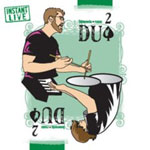 So it has this interesting new-guitar kind of sound. I'm into that, and I'm pretty picky about what goes on in my rig, as far as gear goes. I want to make sure that I play an instrument that vibrates. I don't want to be playing any type of keyboard that is generating a sound digitally. I have nothing against digital equipment, but live, it's kind of a whole 'nother ballgame. There's a hammer that hits a reed in the Wurlitzer, and there's a tone wheel in the organ that makes a tone. Those are my instruments.
So it has this interesting new-guitar kind of sound. I'm into that, and I'm pretty picky about what goes on in my rig, as far as gear goes. I want to make sure that I play an instrument that vibrates. I don't want to be playing any type of keyboard that is generating a sound digitally. I have nothing against digital equipment, but live, it's kind of a whole 'nother ballgame. There's a hammer that hits a reed in the Wurlitzer, and there's a tone wheel in the organ that makes a tone. Those are my instruments.
You know, a guitarist plays his guitar, and the strings vibrate in his hand, and it shouts through the amplifier. As a keyboard player, in order to find that kind of organic, crunchy, natural vibration from your instrument, you pretty much have to go back and get the old stuff. So I've been dealing with a lot of that—figuring out how to maintain those sorts of instruments. I love them, but it's so hard. We did a show with [keyboardist John] Medeski once, and he was changing a reed on one of his Wurlitzers, and I said, "Oh man, I know that. That's a pain in the ass, isn't it? And he said, "Yup, but nothing sounds like this, man. You can't get anything else that sounds like this. And it's the truth. You can get something that sounds like it, but [laughing] it's not it. It doesn't really respond; it doesn't have this personality that you get to play onstage. So it's important for me.
At the same time, I do have this digital keyboard on my rig right now, but if you do have one of those keyboards, it's a good idea to play it through a tube amp to warm it up a little bit. Or go in there and modify the sound a little bit so they don't sound so right, so fake. The only digital thing Medeski's got on his rig is this new digital Moog Voyager thing that Bob Moog made pretty recently—but he plays it through an old Danelectro tube amp or something like that.
AAJ: There are several Joe Russo compositions on the record. "Echo Park, I think, is my favorite song on the album. There's an almost eighties-new-wave texture to that one keyboard melody, but the song also has these neat, interlocking parts—Devo meets Bach, maybe. Any thoughts on this one, Joe?
JR: It was kind of funny—I was staying at Marco's house for a while. I didn't have my own apartment at the time. I was just sitting and playing guitar, and came up with the first riff, and it had this "Jessie's Girl kind of vibe [laughing]. And again, a lot of the stuff I write comes out of this random fucking around. So Marco was out of town and I was downstairs with his roommate, who was helping me with ProTools—I was just layering a bunch of stuff on it, including that synth-ey melody for the song, which was originally supposed to be the bass line. So Marco and I sat down with it, and he used that part as the melody. It was just random, ah, eighties-pop-style-cheese writing [laughing], or something like that. I think that is the cool part of where we're at now—not shying away from anything. Because it really does have that TV-teen-sitcom vibe; at first we were calling it "Not Another Teen Theme Song, and then it was "Echo Park 90210. Then we said, "Well, we don't want to make it too obvious, so we just called it "Echo Park. So that was a fun tune. We were just trying to mess around with different things to do. The album's cohesive, but at the same, it's kind of all over the place. We're just trying to explore as many areas as we can.
AAJ: "Memphis is another Joe Russo composition. It's a country-inflected tune with a perfect blend of minimal drums and minimal guitars—in its first section anyway, and the inclusion of guitar is something new. It's a really sweet arrangement worthy of a Brian Wilson, and the song feels like the ideal ending for the record. I love its little descending melody phrase.
JR: We were playing in Memphis and my girlfriend called me and told me she was moving out. That was the first night I drank Maker's Mark whiskey, which became a problem eventually. We went back to the place we were staying, and I was all depressed, and I just started playing guitar. That's what came out. So one day Marco and I sat down and played it—he'd heard me playing it for a while on my guitar—and I was playing guitar and he was playing piano, and we said, "Fuck it, man. Let's push this into our thing. That was the first time we put guitar into what we do. It ended up really growing on us and we came up with a solid arrangement. So we recorded it for the record, and I was so happy with the way it came out. I do love that it closes the album; it's a nice breath at the end.
Tags
About Benevento/Russo Duo
Instrument: Band / ensemble / orchestra
PREVIOUS / NEXT
Support All About Jazz
 All About Jazz has been a pillar of jazz since 1995, championing it as an art form and, more importantly, supporting the musicians who make it. Our enduring commitment has made "AAJ" one of the most culturally important websites of its kind, read by hundreds of thousands of fans, musicians and industry figures every month.
All About Jazz has been a pillar of jazz since 1995, championing it as an art form and, more importantly, supporting the musicians who make it. Our enduring commitment has made "AAJ" one of the most culturally important websites of its kind, read by hundreds of thousands of fans, musicians and industry figures every month.












